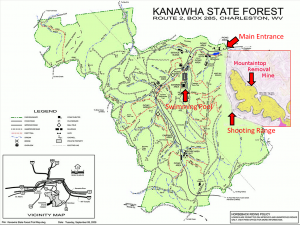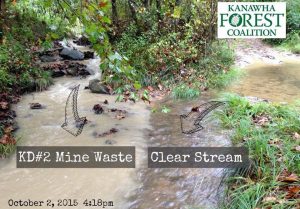Front Porch Blog
Special to the Front Porch: Today we feature a guest post from the Kanawha Forest Coalition, a network of local residents and organizations that formed to fight the KD#2 mountaintop removal coal mine. Pressure from citizens led West Virginia regulators to adopt an especially strict permit for the KD#2 mine, which is adjacent to the Kanawha State Forest. Still, mine operators repeatedly violated their permit and polluted nearby waterways. Citizens repeatedly notified state regulators of the violations, and the state recently ordered a permanent stop to mining.
The KD#2 strip mine next to Kanawha State Forest has been permanently shut down following two years of citizen action.
The West Virginia Department of Environmental Protection has ordered a permanent stop to mining on the controversial KD#2 mountaintop removal strip mine adjacent to Kanawha State Forest following two years of action by the Kanawha Forest Coalition.
The KD#2 permit, approved by the DEP in May 2014 over strong community objections and warnings of likely impacts to water quality, allowed for strip mining and explosive blasting within 588 feet of Kanawha State Forest and 1,500 feet of homes in Loudendale, just outside Charleston city limits.
The Consent Order, signed by DEP’s Director of Mining and Reclamation following a year of negotiations with the Coalition and the permit holder, Keystone Industries, states that “No additional mineral removal activities may occur on this permit. Activity is exclusively restricted to actions necessary to achieve phased release of the permit”. Approximately 100 acres of the original 413-acre permit area was mined, but active mining had been temporarily suspended since early 2015, leaving three quarters of the permit area undisturbed.
“This is a victory for the people of West Virginia and a powerful demonstration of the impact citizens can have when we take a stand, stay persistent, and don’t back down,” said Coalition coordinator, Chad Cordell. “Many people thought this strip mine was unstoppable when the permit was issued over two years ago, however we doubled down in our determination to protect our streams, health, and mountains.”
The order stems from a pattern of violations and temporary cessation orders at the mine site over the past two years for drainage and sediment control failures, off-site erosion, failure to monitor water quality at the mine and in an adjacent landowner’s drinking water, and persistent acid mine drainage into tributaries of Davis Creek. The majority of violation notices were initiated based on citizen monitoring data submitted to the DEP by the Coalition.
The KD#2 mine was first proposed in 2009. The proposed permit went through several major changes before final approval in 2014, including removal of a proposed valley fill and the creation of buffer zones around streams to avoid the need for a federal “dredge and fill” permit under the Clean Water Act. Even with these changes, the nearby streams have been adversely impacted.
“The lessons learned at the KD#2 mine should be a wake-up call to WV residents, lawmakers, and regulators that even the best engineering and the closest scrutiny can’t make strip mining safe for our water, our health, or our communities,” Cordell said. “We now have perpetual pollution, including acid mine drainage, into tributaries of Davis Creek. It should come as no surprise, to the DEP or anyone else, that strip mining pollutes water.”
Under current law, a surface coal mine cannot adversely impact adjacent land or water outside of the permit boundary, nor can it contaminate the water leaving the permit in violation of water quality standards. Applications for surface mines must include information about how the operator will prevent toxic mine discharge. The KD#2 permit application stated that the mine was not anticipated to have the potential for generating acid mine drainage.
“The legality of strip mining is built on a mountain of false assumptions. To really look closely at the conditions on the ground, as we have, and not the fantasy assumptions on paper, means having to accept that mountaintop removal and other types of strip mining simply cannot be done without irreparable harm to our land, water, and health. It’s up to us to tear down the coal industry’s mountain of lies as effectively as they’ve torn down the mountains of our homeland,” Cordell said. “We sincerely commend the DEP for taking steps to address the many issues at the KD#2 mine, but these are not isolated problems. They are widespread problems inherent in strip mining. This campaign was never about stopping just this one mine. It’s about shining a bright light on the issue of strip mining and showing just how damaging it really is. Many other communities are being hurt by strip mining and both the DEP and our state lawmakers need to acknowledge and act on the reality of strip mining’s widespread impacts.”
The WV DEP website currently lists over twenty other surface mine applications, including the Long Ridge #2 and Center Contour surface mines, which are being actively contested by Coal River Mountain Watch, a Raleigh County based citizens’ group.
Editor’s Note: For more information, visit the Kanawha Forest Coalition’s website at kanawhaforestcoalition.org. You can also read a statement from local activist Daile Boulis on our blog and an article about the mine from the August/September 2014 issue of The Appalachian Voice.
PREVIOUS
NEXT

Leave a comment
Your email address will not be published. Required fields are marked *




Leave a Comment